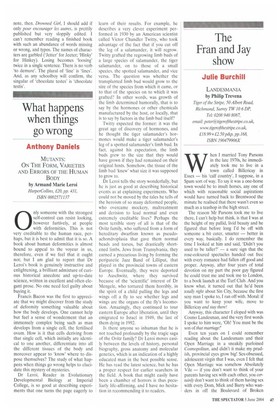What happens when things go wrong
Anthony Daniels
MUTANTS: ON THE FORM, VARIETIES AND ERRORS OF THE HUMAN BODY by Armand Marie Leroi HarperCollins, £20, pp. 431, ISBN 0002571137 Only someone with the strongest self-control can resist looking, however furtively, at people with deformities. This is not very creditable to the human race, perhaps, but it is best to admit that it is so. A book about human deformities is almost bound to appeal to the voyeur in us, therefore, even if we feel that it ought not; but I am glad to report that Dr Leroi's book is genuinely instructive and enlightening, a brilliant admixture of curious historical anecdote and up-to-date science, written in excellent and often elegant prose. No one need feel guilty about buying it.
Francis Bacon was the first to appreciate that we might discover from the study of deformity something valuable about how the body develops. One cannot help but feel a sense of wonderment that an immensely complex being such as man develops from a single cell, the fertilised ovum. How is it that cells deriving from that single cell, which initially are identical to one another, differentiate into all the different tissues of the body and moreover appear to 'know' where to dispose themselves? The study of what happens when things go wrong helps to elucidate this mystery of mysteries.
Dr Leroi, Reader in Evolutionary Developmental Biology at Imperial College, is so good at describing experiments that one turns the page eagerly to learn of their results. For example, he describes a very clever experiment performed in 1930 by an American scientist called Victor Chandler Twitty, who took advantage of the fact that if you cut off the leg of a salamander, it will regrow. Twitty grafted the regrowing limb buds of a large species of salamander, the tiger salamander, on to those of a small species, the spotted salamander, and vice versa. The question was whether the transplanted limb bud would grow to the size of the species from which it came, or to that of the species on to which it was grafted? In other words, was growth of the limb determined humorally, that is to say by the hormones or other chemicals manufactured by the host, or locally, that is to say by factors in the limb bud itself?
Twitty expected the former: it was the great age of discovery of hormones, and he thought the tiger salamander's hormones would make a tiger salamander's leg of a spotted salamander's limb bud. In fact, against his expectation, the limb buds grew to the size that they would have grown if they had remained on their original hosts. Somehow, the tissue of the limb bud 'knew' what size it was supposed to grow to.
Dr Leroi tells the story wonderfully, but he is just as good at describing historical events as at explaining experiments. Who could not be moved by the tales he tells of the heroism of so many deformed people, who overcame mockery, maltreatment and derision to lead normal and even extremely creditable lives? Perhaps the most terrible story of all is that of the Ovitz family, who suffered from a form of hereditary dwarfism known as pseudoachondroplasia that gave them normal heads and torsos, but drastically shortened limbs. Jews from Transylvania, they earned a precarious living by forming the peripatetic Jazz Band of Lilliput, that played in the provincial towns of eastern Europe. Eventually, they were deported to Auschwitz, where they survived because of the 'scientific' interest of Dr Mengele, who tortured them horribly, in the spirit of a child pulling the legs and wings off a fly to see whether legs and wings are the organs of the fly's locomotion. Amazingly, they continued to tour eastern Europe after liberation, until they emigrated to Israel in 1949, the last of them dying in 1992.
Is there anyone so inhuman that he is not touched profoundly by the tragic saga of the Ovitz family? Dr Leroi moves easily between the levels of history, personal biography, gross anatomy and molecular genetics, which is an indication of a highly educated man in the best possible sense. He has read the latest science, but he has a proper respect for earlier searchers in the field. A book that might easily have been a chamber of horrors is thus peculiarly life-affirming, and I have no hesitation in recommending it to readers.










































































 Previous page
Previous page